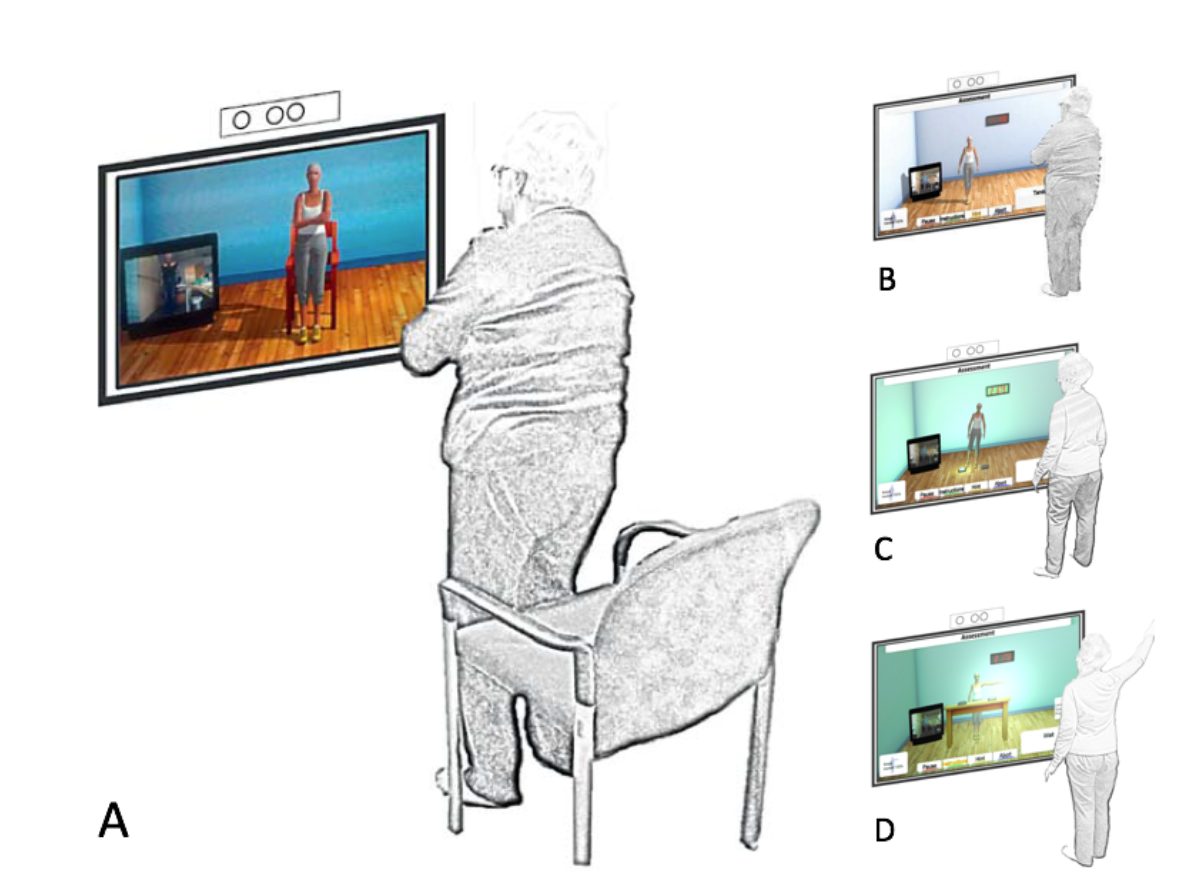An accurate assessment of fall risk could assist to identify older people at increased risk and would enable appropriate intervention strategies before a fall occurs. Recent technological advances hold promise for more accurate and objective assessments. But, how can we achieve regular and cost-efficient assessments? One solution could be to develop self-assessment approaches that empower people to take an active role in their own health management.
We developed a Kinect-based system, which can be connected to a normal TV, for the self-assessment of fall risk at home. Various tests of balance, strength and reaction time were implemented into the assessment software (Figure). In our publication in the Journal Gerontology, we focused on the Kinect-based five-times-sit-to-stand implementation (Figure A) and investigated the feasibility and validity of this test to identify older people at increased risk of falling.
 Figure: Participant performing the Kinect-based (A) five-times-sit-to-stand, (B) balance, (C) stepping reaction time, (D) reaching reaction time test in front of a TV.
Figure: Participant performing the Kinect-based (A) five-times-sit-to-stand, (B) balance, (C) stepping reaction time, (D) reaching reaction time test in front of a TV.
We validated the Kinect-based five-times-sit-to-stand test with 94 community-dwelling older people aged 65 years or older in the laboratory. Afterwards, we installed the system into the participants’ homes. We developed a signal processing algorithm to extract fall risk-related measurements (temporal and spatial) from the Kinect sensor data and then validated the derived performance measurements by comparing the results of previous fallers and non-fallers.
Fallers performed significantly worse than non-fallers on the Kinect-based five-times-sit-to-stand measurements. Participants were satisfied with this technological approach and performed the five-times-sit-to-stand test on a regular basis. The home-based measurements were significantly correlated to the laboratory measurements indicating that this test could be used to assess fall risk at home.
This study was an important first step towards the development of a novel self-assessment solution. An assessment conducted at home could have several advantages over a clinical assessment. It might be more convenient and would provide an easy access for people living in rural and remote areas with limited access to proper health care. Home-based assessments are conducted in a person’s natural environment which might lead to more accurate and representative results of a person’s real life performance. With further research, such assessment tests may prove useful as a measure for monitoring fall risk changes over time as well as the effects of fall prevention interventions.
Publication
A. Ejupi, M. Brodie, Y. J. Gschwind, S. R. Lord, W. L. Zagler, and K. Delbaere, “Kinect-Based Five-Times-Sit-to-Stand Test for Clinical and In-Home Assessment of Fall Risk in Older People.” Gerontology, vol. 62, no. 1, 2016
https://www.karger.com/Article/FullText/381804
About the Author

Andreas Ejupi
Department of Biomedical Physiology and Kinesiology, Simon Fraser University
Andreas Ejupi is interested in engineering in medicine and healthcare. In his research, he focusses on assistive technologies to support older people and people with chronic diseases with a special interest in new sensor-based methods to prevent falls.
Andreas is a postdoctoral fellow at the Simon Fraser University (Department of Biomedical Physiology and Kinesiology). The study presented here was part of his doctoral research at the Austrian Institute of Technology (Department of Safety and Security) and Neuroscience Research Australia (Falls and Balance group).
Copyright
© 2018 by the author. Except as otherwise noted, the ISPGR blog, including its text and figures, is licensed under a Creative Commons Attribution-ShareAlike 4.0 International License. To view a copy of this license, visit https://creativecommons.org/licenses/by-sa/4.0/legalcode.
ISPGR blog (ISSN 2561-4703)
Are you interested in writing a blog post for the ISPGR website? If so, please email the ISGPR Secretariat with the following information:
- First and Last Name
- Institution/Affiliation
- Paper you will be referencing
